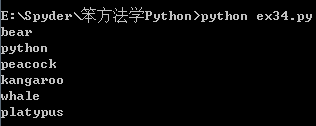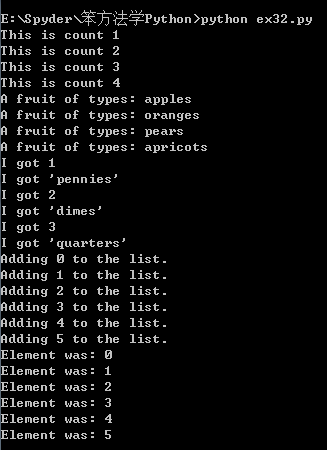习题 32:循环和列表
the_coount = [1, 2, 3, 4]
fruits = ['apples', 'oranges', 'pears', 'apricots']
change = [1, 'pennies', 2, 'dimes', 3, 'quarters']
# this first kind of for-loop goes through a list
for number in the_coount:
print("This is count %d" % number)
# same as above
for fruit in fruits:
print("A fruit of types: %s" % fruit)
# also we can go through mixed lists too
# notice we have to use %r since we don't know what's in it
for i in change:
print("I got %r" % i)
# we can also build lists, first start with an empty one
elements = []
# then use the range function to do 0 to 5 counts
for i in range(0, 6):
print("Adding %d to the list." % i)
# append is a function that lists understand
elements.append(i)
# now we can print them out too
for i in elements:
print("Element was: %d" % i)
常见问题回答:
为什么 for 循环可以使用未定义的变量?
循环开始时这个变量就被定义了,当然每次循环它都会被重新定义一次。
range() 函数可创建一个整数列表,一般用在 for 循环中,会从第一个数到最后一个数,但不包含最后一个数。
append() 函数在列表尾部添加元素。
习题 33:while 循环
i = 0
numbers = []
while i < 6:
print("At the top i is %d" % i)
numbers.append(i)
i = i + 1
print("Numbers now:", numbers)
print("At the bottom i is %d" % i)
print("The numbers:")
for num in numbers:
print(num)

附加练习:
使用 for 循环和 range 把这个脚本再写一遍。
numbers = []
for i in range(6):
print("At the top i is %d" % i)
numbers.append(i)
print("Numbers now:", numbers)
print("At the bottom i is %d" % i)
习题 34:访问列表的元素
animals = ['bear', 'python', 'peacock', 'kangaroo', 'whale', 'platypus']
for i in range(len(animals)):
print(animals[i])

Python 列表从 0 开始。
